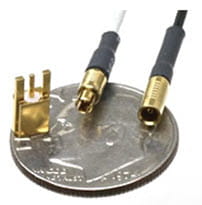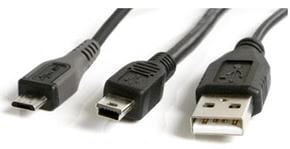The performance demands of portable electronics are resulting in both new connector designs and modifications to long-established connector standards in areas ranging from fast-moving IoT applications to military equipment, where product lifetimes are measured in decades. Here’s what’s changed and how you can take advantage.
High-Density Connectors
Even though space is at a premium in portable devices such as smartphones and tablets, there are still quite a few signals to move from one board to the next. In response, manufacturers have developed ultra-low-profile micro-miniature Board-to-Board (BtB) connectors, which feature high pin-counts and small sizes. The interconnect medium is usually Flexible Flat Cable (FFC) or Flexible Printed Circuit (FPC).
For example, TE Connectivity offers a 0.35 mm fine-pitch scalable BtB connector with a body width of only 1.85 mm and a height as low as 0.6 mm. Another TE fine-pitch BtB connector includes an integrated EMI shield, as shown below. These connectors are designed for smart phones, tablets and portable games.

Figure 1: FPC connector with EMI shield. (Source: TE Connectivity)
Portable Doesn’t Just Mean Handheld
The portable revolution doesn’t just apply to battery-powered devices you can hold in the palm of your hand. Many pieces of equipment that formerly once needed a whole room to themselves are now mobile, requiring all of their components to be mobile as well.
Take medical x-ray machines, for example. Portable systems are today quite commonplace, bringing diagnostic capability directly to the patient. Since they still require operating voltages up to 75 KV, manufacturers had to develop miniature high-voltage connectors.
Even military drones, or UAVs, are getting on the portable bandwagon. Forget about the Reaper with its 84-foot wingspan. The excitement these days is centering on much smaller unmanned vehicles the size of insects that can be handled by a single soldier.
New connector designs based at .025" on center contacts offer military-level quality and reliability, suitable for the latest breeds of UAVs. These nano-miniature interconnects are specifically designed to meet demanding MIL standards that include 100g shocks and vibration testing from 10-2,000 Hz at 20g amplitude.
RF Connector Developments
The trend of shrinking existing functions includes RF as well. The Molex SSMCX, featured below, is a super small micro-coaxial (MCX) connector developed for very small radio and antenna applications. Operating at up to 10 GHz, it is 30 percent smaller than the predecessor MMCX (micro-miniature coax). Their first application? An IEEE 802.11x radio and antenna for a notebook computer.

Figure 2: SSMCX micro-miniature coaxial RF connectors. (Source: Molex)
Another trend driving connector innovation further down the supply chain is the combination of multiple RF technologies such as cellular, Bluetooth, GPS and WLAN into a single handheld device.
The chips that integrate these functions are themselves shrinking in size, causing problems for manufacturers of semiconductor test equipment who must develop high-density RF load boards to test multiple RF integrated circuits simultaneously in a high-volume manufacturing environment.
The solution? Multiport mini-coax connectors, which combine up to eight independent coaxial channels in a single housing.
Battery Connectors Are Smaller and Flatter
Traditional battery connectors have been available for years with two distinct contact configurations. Stamped cantilever contacts provide a more economical interconnect for volume consumer electronic-level products, whereas spring-loaded “pogo pins” are chosen for industrial applications to provide extended cycle life.
In keeping with the trend found in other areas, ongoing reductions in equipment size are forcing battery connectors to slim down as well. Surface-mount battery connectors are finding increasing use in space-constrained portable applications.
Existing Form Factors Aren’t Immune
As portable devices become capable of more and more functions, the drive toward smaller size is affecting existing standards, as seen by successive generations of USB connectors. The original USB form factor was just fine for standard-sized desktops and laptops and is still for the most part used in those devices.
But as phones, tablets and PDAs became more popular, the mini-USB was introduced. As smartphones, digital cameras and other portable devices grew ever thinner, the micro-USB was announced by the USB Implementers Forum (USB-IF) in January 2007. A micro-USB is similar in width to a mini-USB, but it is approximately half the thickness.

Figure 3: Comparison of micro, mini and standard USB connectors. (Source: Wise Geek)
This trend for mini and micro variations is evidenced in other form factors, too. For example, the High-Definition Multimedia Interface (HDMI) standard, used for transferring digital audio and video, is now offered in full size, mini and micro versions.
The latest USB connector innovation is the USB 3.1 Type C connector, which combines data transfer, video output and charging capabilities into a single, reversible connector that is just 2.6mm in height. It offers up to 10Gbps data transfer and up to 100W of power delivery with up to 20V and 5A. Click here to view the complete list of game-changing benefits of USB 3.1 Type C.
Changes in connectors are transpiring even in the relatively slow-moving industrial market. Next-generation micro-D high-density connectors provide four times the density of standard sub-D connectors.
Replacing Connectors with Wireless Methods
Given the extreme slimness of many handheld devices, manufacturers are looking at whether they can entirely replace connectors with wireless solutions, which is not the best news for connector manufacturers.
Two common areas that are seeing this direction are in wireless speakers and wireless charging. After Apple replaced its 30-pin dock connector with the new 8-pin lightning connector that no longer contained line-level audio outputs, speakers with mobile docks began to decline in popularity in favor of wireless solutions. And wireless charging has made its appearance on a number of laptops and smartphones, only to be followed by wearable devices such as the Apple Watch, which uses wireless inductive charging. It is expected that this trend will continue with consumer portable electronics.
The rise of portable products has resulted in a proliferation of new connector technologies, as well as an expansion of some old standards to accommodate new realities. We can only anticipate that the future of connector innovation will continue to be driven by the trends and consumer needs of the electronic devices they connect, communicate and power.


